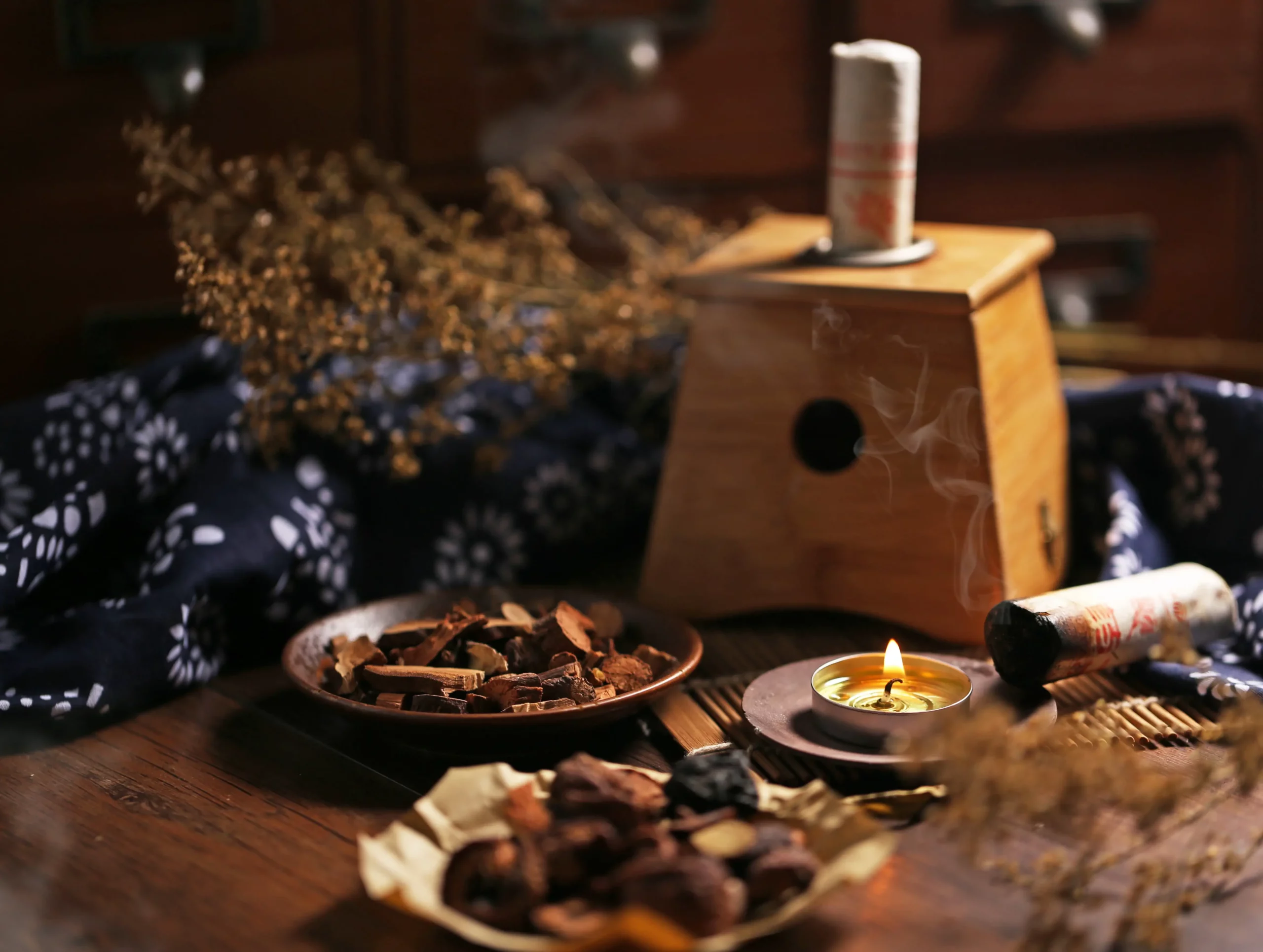Moxibustion is an ancient practice of Chinese Medicine and is used to warm the flow of Qi in the body, promote circulation, and get rid of certain pathogenic influences. Moxa is valued for its ability to strengthen the blood, stimulate the flow of Qi, and maintain general health. Acupuncture and moxibustion are often used in conjunction, to get the maximum therapeutic effects of both treatments.
What Is Moxibustion?
Moxibustion is a traditional Chinese medicine technique defined by its unique method of healing, which uses the burning of mugwort, a small, spongy herb, to promote healing. The moxibustion definition includes the process of stimulating specific acupuncture points on the body by applying heat from a moxibustion stick, which is a tightly rolled stick of dried mugwort leaves, directly or indirectly above the skin.
This practice is believed to promote the flow of Qi (vital energy) and blood in the body, helping to treat conditions ranging from chronic pain to digestive disorders. The heat generated by mugwort warms the acupuncture points, which can lead to a smoother flow of blood and Qi, helping the body’s natural healing processes and contributing to overall health.
How is Moxa Used?
Here is a general idea of how moxibustion therapy is typically used based on traditional practices:
- Choose the Type of Moxibustion. Decide between direct and indirect moxibustion.
- Prepare the Area. Clean the area of the skin where moxibustion will be applied. This is particularly relevant for direct moxibustion.
- Light the Moxa Stick. Ignite one end of the moxibustion stick until it smolders, producing a therapeutic level of heat.
- Apply Heat.
- Monitor the Heat. Ask for feedback on the heat’s intensity to ensure comfort and safety. The heat should be warm and soothing, not painful.
- Extinguish the Moxa Stick. Once the session is complete, safely extinguish a moxa stick.
- Conclude the Session. Follow any final steps such as cleaning the area again if necessary.
Remember, the exact procedure can vary based on the practitioner’s approach and the specific needs of the patient.
Types Of Moxibustion
Moxibustion treatment has two main methods:
- During direct moxibustion, a small, cone-shaped amount of moxa is placed directly on the skin and ignited. This method, while effective, is less commonly used because of a risk of burns but is highly valued for its deep penetrating heat.
- Indirect moxibustion is more commonly practiced. Involves burning mugwort near the skin without direct contact. This allows for a broader area to be treated and is considered safer and more comfortable for the patient.
Specific applications of moxa treatment include moxibustion for breech, where it’s used to encourage a breech baby to turn into a proper birth position, and moxibustion for fertility, aiming to enhance reproductive health by improving blood flow and Qi energy to the pelvic area. These targeted treatments show the adaptability of moxa to address both general and specific health issues effectively.
Benefits of Moxibustion
Moxibustion offers a wide range of benefits. The primary moxibustion benefits include improving circulation and stimulating the flow of Qi (vital energy) throughout the body. This blood flow and energy increase can lead to reduced pain and inflammation, particularly in chronic conditions like arthritis and muscle stiffness. Moxibustion is also known for its effectiveness in boosting the immune system, helping the body to defend against colds and flus more effectively.
It also has a significant impact on digestive health, fighting off symptoms of bloating, constipation, and IBS. For women, moxibustion can offer relief from menstrual cramps and assist in fertility issues. The warming nature of moxa is particularly beneficial for conditions worsened by cold and dampness, making it a popular tool for holistic healing.
Are There Any Risks Of Moxibustion?
Moxa therapy is generally considered safe when performed by a qualified practitioner, though there are some potential risks and side effects to be aware of. The most common risk involves minor burns or blisters, particularly with direct moxibustion where the burning moxa comes into close contact with the skin. Indirect moxibustion significantly reduces this risk but still requires careful monitoring of heat levels to ensure the skin is not overheated.
Smoke inhalation from the burning moxa can also be a concern, especially for those with respiratory issues. However, smokeless moxa options are available to mitigate this. Additionally, pregnant women should seek professional advice before undergoing moxibustion, as certain acupuncture points can stimulate uterine contractions. It’s highly important to consult with a knowledgeable practitioner to discuss any health conditions or concerns you might have prior to receiving moxibustion.
Where to Go for Moxibustion
If you’re looking for a qualified moxibustion provider near New York, NY, scheduling an appointment with Maria Gorens at Firebird Acupuncture is a great choice. Maria is an experienced practitioner who specializes in this ancient technique, offering treatments designed to enhance your health, both physical and mental. But moxibustion isn’t the only service you can expect at Firebird Acupuncture.
We also offer expertise in Feng Shui and Gua Sha. Feng Shui can help harmonize your living or work spaces to promote a healthier, more balanced lifestyle, while Gua Sha is a therapeutic technique that involves scraping the skin to improve circulation. These practices, along with moxibustion, form a well-rounded suite of services aimed at addressing a wide range of health concerns. Visiting Firebird Acupuncture can be a step towards achieving better overall health and balance in your life.



